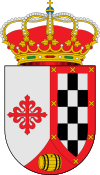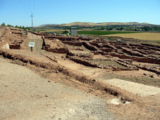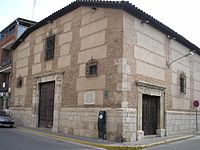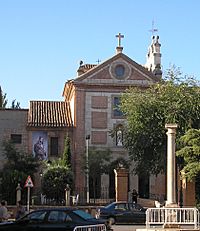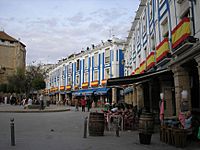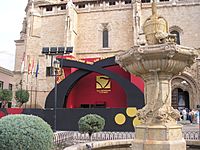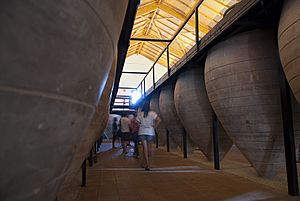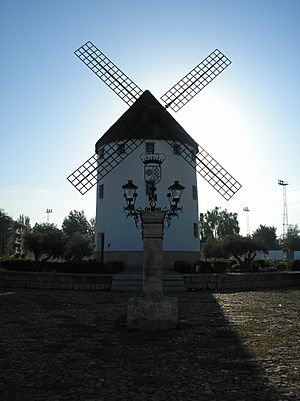Valdepeñas facts for kids
Quick facts for kids
Valdepeñas
|
||
|---|---|---|
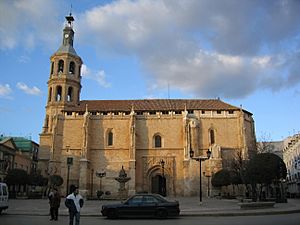
Valdepeñas Spain Church of Assumption
|
||
|
||
| Country | Spain | |
| Autonomous community | Castile-La Mancha | |
| Province | Ciudad Real | |
| Founded | 13th century | |
| Area | ||
| • Total | 487.65 km2 (188.28 sq mi) | |
| Elevation | 705 m (2,313 ft) | |
| Population
(2018)
|
||
| • Total | 30,210 | |
| • Density | 61.950/km2 (160.450/sq mi) | |
| Demonym(s) | Valdepeñeros | |
| Time zone | UTC+1 (CET) | |
| • Summer (DST) | UTC+2 (CEST) | |
| Postal code |
13300
|
|
| Official language(s) | Spanish | |
Valdepeñas is a town and a municipality in the province of Ciudad Real, Spain. It is part of the Castile-La Mancha region. The town is also a legal center for several nearby places. These include Moral de Calatrava and Santa Cruz de Mudela.
Contents
Geography of Valdepeñas
The name Valdepeñas means "Valley of Rocks." This is because it sits in a hilly area. A bend of the Jabalón River surrounds it. The ground here has a lot of limestone rock.
The town is in the Campo de Calatrava. This is a large flat area north of the Sierra Morena mountains. Valdepeñas is on the left bank of the Jabalón River. This river flows into the Guadiana River.
A small village called Consolación is part of Valdepeñas. It is located where two roads meet. This village was built in 1949.
History of Valdepeñas
Early Times
The area around Valdepeñas has many old remains. These include platforms and watchtowers on hills. They are from the Bronze Age, around 1000 to 1300 BC. These structures were built by people known as the Culture of the Motillas.
Ancient Settlements
About eight kilometers south of Valdepeñas is an ancient Iberian city. It is called "Cerro de las Cabezas," meaning "Hill of the Heads." This was a large, fortified town with a castle on top of the hill. People lived there between 700 and 200 BC. This site is important for understanding the Oretana Culture. It also shows the first signs of grapevines in this region.
In later centuries, people found Roman items here. These included graves and coins from a Roman villa. This villa existed from the 1st century BC into the Visigothic period.
Middle Ages
During the Middle Ages, the area was part of the Moorish kingdom of Toledo. Arab writings and a sundial on the Church of the Assumption are from this time. It is said that the rulers allowed people to grow grapes and make wine. This was special because making wine was usually not allowed by their religion. The Moors left Valdepeñas at the end of the 1400s.
After a big battle in 1212, new settlers came to the area. They moved near the old castle, which became the Church of the Assumption. From then on, Valdepeñas belonged to the military Order of Calatrava. The first time Valdepeñas was written about was in 1243. The new settlers came from different parts of Spain. The Order asked them to keep growing grapevines.
In medieval times, a Jewish community grew important here. They had at least two synagogues. One of these later became the Veracruz hermitage.
Early Modern Age
The Catholic Monarchs, Ferdinand and Isabella, stayed in Valdepeñas in 1488. They left their children there while they went to conquer Granada. A local man, Alfonso de Merlo, helped fund this campaign. The monarchs made him a Knight. Some of his family later moved to the Americas.
Many religious and public buildings from the 1500s are still in the town. One example is the Trinitarians Convent.
King Ferdinand the Catholic wanted more control over military groups. So, the Pope gave him power over many towns, including Valdepeñas.
Later, in 1575, King Philip II sold the town. It was bought by D. Alvaro de Bazán, who became the Lord of Valdepeñas. This meant Valdepeñas was no longer controlled by the Order of Calatrava.
The new lords helped make Valdepeñas wines famous. These wines became well-known across Spain.
Recent History
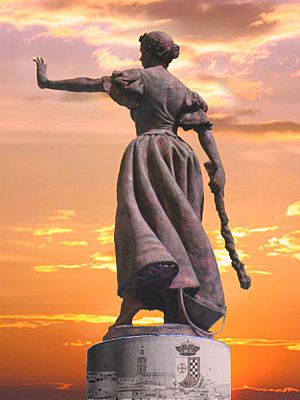
Valdepeñas was a quiet town until 1808. This was when Napoleon's army tried to cross Spain. On June 6, 1808, the people of Valdepeñas fought back. Men and women, even from nearby villages, stopped the French troops. Many lives were lost, and a large fire started. A brave woman named Juana Galán "La Galana" was a hero in this fight. The French troops had to turn back. This delay helped Spain win the Battle of Bailen. King Fernando VII later called Valdepeñas "Very Heroic." After this, some people from Valdepeñas joined guerrilla fighting against Napoleon's army. One famous fighter was Francisco Abad Moreno "Chaleco".
In the early 1900s, a plant disease called Phylloxera affected grapevines. Farmers started using American vines that could resist the disease. The Spanish Civil War (1936-1939) slowed down the town's growth. The population also decreased. From the 1940s to the 1970s, farming and making wine were the main jobs. In the 1980s, Valdepeñas modernized its wine industry. They started growing new types of grapes and using new methods.
Culture
Valdepeñas has several museums. These museums teach about history, art, and wine.
The town holds two main fairs. The "summer fair" is in August. The "Fiesta de la Vendimia" (Grape Harvest Fair) is in September.
Famous People from Valdepeñas
- Bernardo de Balbuena: A poet who became a Bishop in Puerto Rico in 1620.
- Luis Merlo de la Fuente Ruiz de Beteta: A colonial official who was briefly the Royal Governor of Chile.
- Gregorio Prieto: A painter, poet, and illustrator. He was known for portraits and landscapes.
- Francisco Abad Moreno "Chaleco": A famous guerrilla fighter during the Spanish War of Independence.
- Juan Luis Rodríguez-Vigil: A politician who was President of Asturias from 1991 to 1993.
- Ana de Castro Egas: A Spanish poet and writer from the 1600s.
- Alonso de Córdoba: An early settler in Chile. He served as mayor of Santiago several times.
- Juana Galán (La Galana): A brave woman who fought against French soldiers in 1808.
- Francisco Nieva: A writer and playwright. He was a member of the Royal Spanish Academy.
- Carmen García de Merlo: A lawyer and civil servant. She became the first transgender woman to lead COGAM in Madrid.
Economy
In the late 1800s, Valdepeñas grew quickly. It had many factories, like distilleries and flour mills. It was also known for its hot mineral springs. But its most important product was red wine.
Today, Valdepeñas is still famous for its wines. It is a major center for growing grapes. Valdepeñas wines are very popular in Spain and other European countries.
Besides food and wine, Valdepeñas has other industries. These are located in several industrial parks. They include:
- A factory that makes and researches high-tech electronics.
- A center for heavy truck transport.
- The "D. Quixote Route" and a special wine train from Madrid.
Twin towns
 Cognac, France
Cognac, France
See also
 In Spanish: Valdepeñas (Ciudad Real) para niños
In Spanish: Valdepeñas (Ciudad Real) para niños


